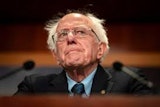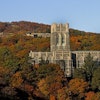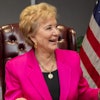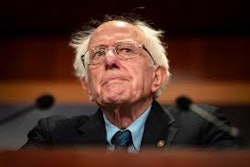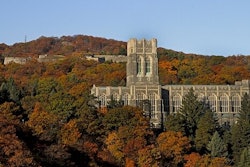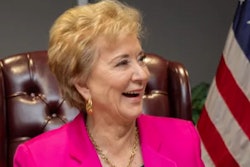After nearly a decade of financial strife, media misrepresentation,
and structural challenges, the University of the District of Columbia
(UDC) received some positive encouragement regarding its future.
The twenty-one-year-old predominately Black university had its
accreditation approved by the Commission on Higher Education of the
Middle States Association of Colleges and Schools after much
speculation that UDC might not reopen its doors next fall. Worries
about accreditation arose in June 1996, when an $18.2 million deficit
forced massive program cuts and layoffs.
On the heels of a Clinton Administration rescue package granting
the university nearly $40 million in support, the commission restored
UDC’s full accreditation late last month.
University officials were pleased with the announcement, noting
that the public’s general perception of UDC has been, in many cases,
mishandled by the media, contributing to its struggle to retain
enrollment.
“It’s important to note that the only reason warning was given to
us in the first place was because the commission was unsure of the
financial support base for the school,” explained Dr. Beverly Anderson,
vice president of academic affairs and the university’s provost. “We’re
pleased because a lot of people were unsure of why our accreditation
was coming into question — it was an uncertainty agitated by [the]
media that our academic standing was in question. This gives us a
chance to clear the air.”
In the midst of Washington, D.C.’s, fiscal crisis and the
development of an overseeing body known as the District’s Financial
Control Board, the campus community as well as the city’s citizenry has
been concerned in recent years about the plight of the only public
university in the nation’s capital. When the control board began
assuming authority over most of the city’s operations late last year,
much of the District endured significant cuts in services and programs.
UDC’s overall budgeted income from the city had already decreased
from $76 million in fiscal 1992 to $43 million in 1995. UDC suffered a
$30 million budget hit in 1996 and was again told to cut an additional
$16.2 million within twelve months of the first cut. In its attempts to
survive, the university laid off faculty and staff and cut programs and
services.
“We’re going to have to cut off some fingers and toes,” said Dr.
Reginald Wilson of the university’s Board of Trustees last year. “But,
the university will be saved.”
Additionally, UDC endured an image crisis.
“Print media used the information in a way that distorted the
problem,” Anderson said. “The slant regarding the warning was taken
that our students are not achievers and that the school offered a
substandard education. It created a greater strain on enrollment.”
In the fall of 1996, enrollment stood at 7,600 and dropped to 6,000
by the spring semester. In comparison, enrollment was at 14,000 in 1980
and dropped to 10,000 by 1995.
Area activists, student leaders, local public servants, and UDC
leadership have long insisted that the university is a primary
wellspring of opportunity for working and older students. Yet, as
recently as June, the control board debated whether to keep the school
as a four-year institution. The debate, cuts and restructuring left
students and faculty in limbo.
“I felt like I was a kid in the middle of a bad divorce between my
parents,” said Veronica McDonald, a journalist and 1996 graduate of
UDC. “We were all wondering what would happen with our futures. And the
worst part was that we knew that our education was quality. It was as
if the parents were doing a great job in raising us, but all anybody
else saw was fighting.”
Mark Thompson of UMOJA, an independent political party with strong
roots in UDC, has been fighting for UDC’s survival for more than five
years.
“Supporting UDC and its future is a matter of what is right for the
people of the District and the future of the nation,” he said.
Still, the outcry from these sources alone did not seem enough to
alter the tumultuous course of UDC. In the eyes of many Washington
decision-makers, Howard University is seen as the primary Black school
in the District while UDC has been perceived as an “academic stepchild”
who is far too needy and not as bright. The average UDC student is
twenty-nine years old with a full-time job.
Motivating area leadership and mobilizing broad-based support were
the beginning of the turning tide for UDC. In addition to voices that
had been stating the case for the school, others come to bear.
“We believe UDC should continue to be a four-year university and
that the faculty should have more say in its future,” Dr. George E.
Holmes chair of coalition committee organized to support UDC and head
of Howard’s American Association of University Professors said to Black
Issues earlier this year. The coalition garnered support from the
area’s academic community, as well as local and congressional political
figures.
Although a number of leaders had already been involved in efforts
to support UDC, the collective actions placed pressure on the Clinton
Administration, the U.S. House of Representatives, the Senate
Appropriations committee, and the Control Board to restore financial
support to UDC.
“Much of what is happening started with the federal government,”
Anderson explained. “But city official and people who UDC can identify
with have come out and responded.
“The decision-makers have come out and issued their financial
support. Remember that even when we had to make the $16 million cut, we
raised over $29 million in grants from the public and private sector,”
she continued. “Those are sources that never stopped believing in UDC.”
COPYRIGHT 1997 Cox, Matthews & Associates
© Copyright 2005 by DiverseEducation.com
